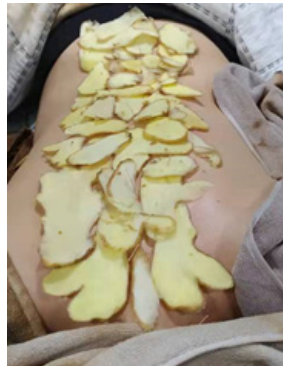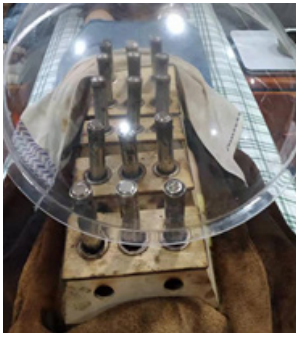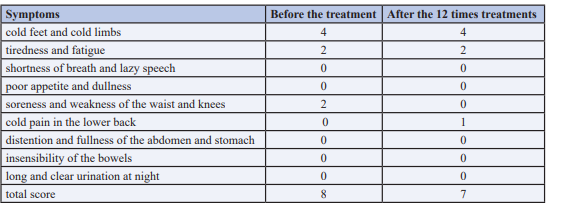Case Report - (2022) Volume 7, Issue 2
A case of chronic fatigue syndrome treated with long snake moxibustion
2The Center for Prevention and Treatment of Hospital of Chengdu University of Traditional Chinese Med, China
3Director of the Center for Prevention and Treatment of Hospital of Chengdu University of Traditional, China
Received Date: Feb 05, 2022 / Accepted Date: Feb 09, 2022 / Published Date: Feb 20, 2022
Abstract
Background: Chronic fatigue syndrome is a syndrome whose pathogenesis is still unclear and whose incidence is increasing every year. There is no widely accepted international standard for the treatment of chronic fatigue syndrome.
Objective: To discuss a 24-year-old patient with chronic fatigue syndrome for more than ten years, with a purpose to introduce a potentially effective treatment for chronic fatigue syndrome.
Conclusion: In this case, long snake moxibustion not only had an immediate body temperature increase effect, but also performed well at early follow-up (5 days after treatments). Not only did long snake moxibustion objectively increase the patient’s cellular metabolic caloric value, but it was also effective in improving the patient’s fatigue and other symptoms, as well as in improving depressed mood.
Keywords
Chronic Fatigue Syndrome, CFS, Long Snake Moxibustion
Introduction
Chronic fatigue syndrome (CFS) is a newly recognized disease in modern medicine, officially named by the Centers for Disease Control and Prevention (CDC) in 1988.The etiology and pathogenesis of CFS are not yet fully understood and the diagnostic criteria are still controversial. Persistent or frequently recurrent clinically unexplained chronic fatigue that is not associated with sustained exertion, is not relieved by rest, has a definite onset and can lead to a significant reduction in the ability to work, study and be active. Fatigue lasting six months or more. Presence of at least four clinical symptoms that follow fatigue and have recurrent or persistent episodes. (1) memory loss or inability to concentrate, which has an impact on the ability to learn, work, perform personal and activities; (2) swelling and pain in the throat; (3) palpable swollen and painful lymph nodes in the axilla or neck; (4) muscle aches and pains; (5) polyarticular pain without redness or swelling; (6) new and more severe headache; (7) sleep does not relieve fatigue; (8) fatigue does not resolve after 24 hours of exercise [1].
The prevalence of CFS has been increasing in recent years in our country due to the high stress of school, life and work. A meta-analysis showed that the prevalence of CFS in the Chinese population was 12.54% [2].
Modern medical research suggests that the etiology and pathogenesis of CFS are mostly related to neuroendocrine abnormalities, immune abnormalities, biological factors, psychosocial factors and genetic factors, and that nutritional therapy with vitamin and other trace elements, psychological tolerance, antidepressants and antiviral drugs are used to treat CFS. In China acupuncture, Tui-Na and cupping are all used to treat chronic fatigue syndrome.
Moxibustion, as one of the characteristic therapies of Chinese medicine, has certain advantages in the treatment of chronic diseases because it is simple, convenient, effective, inexpensive and safe. Long Snake Moxibustion, also known as “Governor’s Moxibustion”, is applied to the first and second lateral lines of the Governor’s and Bladder meridians on the back, like a long snake, hence the name. The treatment has the advantages of wide area, deep heat penetration, strong warming power and long lasting effect compared to single point moxibustion. With the advancement of clinical research, it is now widely used in the treatment of various diseases and has achieved definite efficacy. A variety of studies have shown that long snake moxibustion therapy stimulates the function of meridians, regulates the qi and blood of the internal organs, balances yin and yang, adjusts deficiency and reality, and protects against cold and evil, thus achieving the purpose of preventing and treating diseases.
Materials and Methods
Patient
The patient is a 24-year-old young woman, 167 cm tall and weighing 55 kg. She has been suffering from chronic fatigue syndrome for 10 years until January 4, 2021. When she arrived at our clinic, a series of assessments were carried out. Total score of 11 on the Fatigue Scale-14. 8 points for somatic fatigue and 3 points for mental fatigue. 4 points for chills and cold limbs (scale 0-2-4-6). 2 points for tiredness and lethargy (scale 0-2-4-6). 2 points for weakness in the lower back and knees (scale 0-2-4-6). Depression Self-Rating Scale standard score 41
Before the patient was treated, an infrared thermal tomography scan was performed to derive heat metabolism values for the different areas of the patient. As shown in Table 1.
Table 1: The heat metabolism values for the different areas before the treatments

Treatment
First the patient is placed in the prone position. Exposure of the back and feet. Cut the ginger into thin slices 2-3 mm thick. Lay the heated ginger slices flat on the patient’s entire back. 5-6 three-hole moxibustion boxes are placed along the Vessel of the Governor, the first and the second lateral line of the bladder. Place 1 singlehole moxibustion box on each of the KI1. Keeps the moxa burning for 1 hour. As shown in Figure 1 and 2.2 sessions per week, 12 treatments in total.

Figure 1: Lay the heated ginger slices flat on the patient’s entire back.

Figure 2: 5-6 three-hole moxibustion boxes are placed along the Vessel of the Governor, the first and the second lateral line of the bladder.
Results
Visit 1: January 4, 2021. Before and after the first treatment, we recorded the changes in body surface temperature at different sites, as shown in Table 2. From the table we can see that there was an immediate increase in the patient’s back temperature. During the treatment, the patient complained of heat transmission from the back to the chest, from the lower back to the abdomen, from the back to the neck and from the lower back to the buttocks, as well as a heat wave sensation.
Table 2: Body surface temperature at different sites before and after the first treatment

Visit 2: February 19, 2021. Before and after the last treatment, we recorded the changes in body surface temperature at different sites again, as shown in Table 3. As can be seen from the table the temperature in most parts got an immediate rise.
Table 3: Body surface temperature at different sites before and after the last treatment

Visit 3: February 25, 2021. Patients were assessed again on the fifth day after all treatments were completed and infrared thermal tomography scans were performed. The patient’s total score on the fatigue scale was reduced from 11 to 6, with physical fatigue reduced from 8 to 4 and mental fatigue reduced from 3 to 2 (as shown in table 4). The patient’s symptom score was reduced from 8 to 7 (as shown in table 5). The patient’s standard score on the Depression Self-Rating Scale was reduced from 41 to 39 (as shown in table 6). Using infrared thermal tomography we obtained thermal metabolic values for the different areas of the patient as shown in Table 7. Compared to Table 1, the patient’s heat metabolism values improved significantly after treatments.
Table 4: The Fatigue Scale-14

Table 5: The Symptom score.

Table 6: Depression Self-Rating Scale and Anxiety Self-Assessment Scale

Table 7: The heat metabolism values for the different areas after the treatments.

Discussion
It is now generally accepted that the pathogenesis of chronic fatigue syndrome is broadly classified as follows: viral infection, neuroendocrine disorders, autoimmune dysfunction, oxidative stress, psychosocial, etc. Current modern medical treatment for CFS is generally based on antiviral, antidepressant, immunosuppressive, analgesic, sleep improvement, antihistamines, antioxidants, and exercise cognitive therapy. At present, Western medicine is only able to provide partial relief of clinical symptoms in the treatment of CFS and does not achieve effective improvement.
Chronic fatigue syndrome has no corresponding name in the TCM. Based on its clinical symptoms, it can be classified under the category of “deficiency labour disease” in Chinese medicine. The mechanism of moxibustion for chronic fatigue syndrome may be related to boosting immunity. Several studies [3-5] have shown that moxibustion can have a positive effect on IgG, IgA, IL-2, INF-γ, CD3+ in patients with chronic fatigue.
In this case, the treatment of chronic fatigue syndrome with long snake moxibustion yielded good results. It is worthwhile to further explore the role and mechanism of action of long snake moxibustion in people with chronic fatigue syndrome.
References
1. Fukuda K, Straus SE, Hickie I, Sharpe MC, Dobbins JG, et al. (1994) The chronic fatigue syndrome: a comprehensive approach to its definition and study. International Chronic Fatigue Syndrome Study Group. Ann Intern Med 121(12): 953-959.
2. Wu Qiao, Gao Jing, Bai Dingxi, et al. (2020) Meta-analysis of the prevalence of chronic fatigue syndrome in the Chinese population. Right River Medicine 48(10): 727-735.
3. Lin Yumin, Jiang Ganghui (2017) Clinical efficacy of moxibustion at Qihai and Guangyuan acupoints for the treatment of chronic fatigue syndrome and its effect on immune function in rats. Guangxi Medicine 39(10): 1546- 1549.
4. Luo H L, Chen S M, Yu S M, et al. (2018) Effectiveness of thunder fire moxibustion in the treatment of chronic fatigue syndrome and its effect on peripheral blood T lymphocyte subsets. China Medicine Herald 15(22):107-111.
5. Luo Daihong, Huang Qiong, Lv Xianghua, et al. (2017) Effects of Fu Yang moxibustion on serum interleukin 2 and γ-interferon levels in patients with chronic fatigue syndrome with spleen and kidney yang deficien
Copyright: © 2025 This is an open-access article distributed under the terms of the Creative Commons Attribution License, which permits unrestricted use, distribution, and reproduction in any medium, provided the original author and source are credited.



